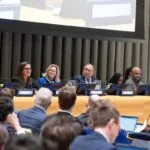Comparing nuclear accident responses at Three Mile Island, Chernobyl, and Fukushima
By Daine L. Danielson, Vladimir Kobezskii, Anna Kudriavtseva, Ariel Petrovics | August 31, 2020
 A welcoming banner in one of the abandoned small towns immediately outside the ruined Fukushima Daiichi power plant says “Nuclear Power is Our Future.”
A welcoming banner in one of the abandoned small towns immediately outside the ruined Fukushima Daiichi power plant says “Nuclear Power is Our Future.”
The viability of nuclear energy has long focused on concerns about nuclear safety. The government and industry responses to the three major nuclear reactor accidents—Three Mile Island (TMI), Chernobyl, and Fukushima—offer insights about how to prevent and respond to nuclear accidents. While there is no perfect strategy for prevention or response, past experience can and should inform decisions on regulating nuclear power in the future. The following comparison of three accidents reveals that independent oversight and a strong safety culture are paramount to rapid response, organized evacuation and repopulation, and clear communication to local publics during and after an accident at a nuclear power plant.
Physical aspects of the response to a nuclear accident. Immediately following a nuclear power plant accident, the first goal of the physical response strategy is to manage radiation exposure and minimize public safety risks. However, these rapid responses are often carried out in conditions of poor information; the extent of damage to a nuclear reactor and resulting risk zones are still unknown. Each of the three major nuclear reactor accidents has spurred at minimum a rapid response to events unfolding at the reactor site, but the wider physical responses reveal contrasting approaches.
At Fukushima, a prompt and organized evacuation prevented any radiation-related casualties despite dangerous radioactive dispersal. Nonetheless, it is estimated that over 2,200 disaster-related deaths stemmed from maintaining the evacuation, demonstrating that the very measures taken to prevent radiation exposure can incur secondary public safety risks “in contrast to the little risk from radiation if early return had been allowed.” In comparison the response at Three Mile Island was similarly prompt, but the evacuation procedure was less organized. Contradictory messages from the government and public media spurred an estimated 144,000 of the local population to self-evacuate despite limited radiation levels, resulting in 12 casualties. Last, immediate safety measures at Chernobyl were hampered by government attempts to keep the extent of the damage secret and a widespread, politically motivated belief that the RBMK reactor of the type at Chernobyl was inherently failsafe. This delayed response increased the public health risks from prolonged radiation exposure, resulting in heightened rates of pediatric thyroid cancer and radiation poisoning in the surrounding area.
Debate continues on the correct balance between radiation exposure risks on one hand and evacuation, displacement, and repopulation risks on the other. At TMI, where no significant radiation was released, radiation risk was not a primary concern after initial evacuations. At Chernobyl, due to the severity of the release, a 30-kilometer radius was evacuated and remains largely unpopulated. At Fukushima, however, a radiation threshold of 20 millisieverts per year was used to determine evacuation need. This level is widely accepted as safe, but has raised controversy, as some consider it to be far too conservative for use in a disaster scenario, given the known public health costs of evacuation and displacement. Finding the best path forward for public health, therefore, requires a holistic view of radiation risks in combination with evacuation, displacement, and repopulation risks.
The three accidents demonstrated different long-term prevention and repopulation strategies. While the limited radiation release at TMI allowed for rapid repopulation, lingering radiation at both Chernobyl and Fukushima have prevented a complete resettlement. In Chernobyl, nearly all of the 350,000 evacuees were permanently relocated as the radiation leaks and persisting health risks continue. However, some locals refused to leave the area, and some even returned to the borders of the exclusion zone despite the risks. Finally, in the case of Fukushima, large radiation releases and the related health risks—due in part to the earthquake and tsunami that precipitated the nuclear accident—necessitated widespread evacuation of over 160,000 people. Resettlement, however, has been slow, with over 80,000 of those evacuees still affected and ongoing efforts to resettle these displaced groups. The fact that only one radiation-related death has occurred at Fukushima may be partly credited to the successful initial evacuation. However, as the displacement continues, evacuation-related deaths also mount, illustrating the aforementioned delicate balance between evacuation risks and the need for radiation safety.
Preventive measures. Following the accidents, each of the three governments implemented new preventive measures, such as reactor upgrades and stricter safety and inspection standards. The United States redesigned reactor control readouts and fail-safes following TMI. After Chernobyl, the Soviet Union upgraded RBMK reactors to reduce the propensity of boiling coolant to increase reaction rates in an already overheating core, and moved to safer pressurized light water reactor designs for all new construction. In Japan, the government established new regulatory standards for nuclear power plants. However, it remains to be seen if Japan will decide to forsake nuclear power entirely, precluding the risk of future accidents but incurring possible economic and environmental costs.
Averting future accidents will require more than technical upgrades. Facility management and oversight jurisdiction must be enhanced to prevent accidents and improve emergency response. For TMI and Chernobyl, the US and Soviet governments made significant improvements in nuclear regulation. For example, the US Nuclear Regulatory Commission enforcement office was strengthened and the nuclear industry created the Institute of Nuclear Power Operations to drive safety and reliability improvements. In Russia, a strong safety culture was implemented for Russian reactor operations as a result of lessons from Chernobyl. In Japan, the private Tokyo Electric Power Company (TEPCO) operated its plant with weak government oversight and strict conformity to business goals. This brought profit and safety incentives into conflict, thus undermining safety culture and accident mitigations before and during the response. To prevent such conflicts in the future, Japan has brought nuclear power under more stringent national oversight, improving safety standards and streamlining response procedures. This change is still ongoing, however, and it is unclear if the industry will remain viable as nuclear power production is still largely suspended in Japan. Nonetheless, the examples of TMI and Chernobyl suggest that strict government oversight serves to mitigate risks and improve accident response.
The differences in preventive measures, immediate physical responses, and long-term changes in regulation demonstrate that every strategy imposes benefits and risks. There is no perfect prevention or response strategy, but comparing the historical approaches will help nuclear-powered nations develop optimal strategies to minimize risks.
Government messaging to the public. The three accidents also differed in the ways by which information was shared with local publics and the international community. The US and Japanese governments immediately issued public notices informing the local residents of the accidents, providing risk assessments, and issuing specific evacuation instructions. The Soviet Union communicated slowly due in part to strict government controls over the media and early attempts to conceal the cause and extent of the accident.
The political institutions and relevant regulations in the three countries also affected how officials communicated with their publics. Independent freedom of press laws in the United States ensured rapid communication to the public, but also allowed media reports to eclipse official scientific evaluations. This reporting fomented public fear despite relatively low radiation risks, resulting in some populations not at risk to choose to flee the area. Today, there remains a lingering negative public attitude toward nuclear energy due in large part to the enduring fears associated with the TMI accident. Following the accident, the United States made no changes to independent media legislation, though new laws were enacted to improve nuclear plant safety culture, including operator licensing, training for emergencies, and more stringent power plant regulations.
In comparison, government control of the media in the Soviet Union prevented full disclosure of the Chernobyl accident in the days immediately following the accident. This limited information resulted in much of the public being initially unaware of the extent of the damage and remaining in contaminated areas despite the health risks of doing so. While the government experienced an initial loss in public support for nuclear energy in the short term, support has since returned following improvements to the safety culture in the Russian nuclear industry. In addition, while ongoing reactor construction stalled immediately after the incident due to acute funding shortages related to economic reforms and the dissolution of the Soviet Union, construction was resumed in the late 1990s as funds again became available and Russia switched to modern, safer light water reactors.
Following the fall of the Soviet Union, the Russian Federation quickly enacted legislation to ensure more rapid communication in public emergencies. The public health ramifications from the early delays at Chernobyl led the Russian Federation in 1996 to enact information guarantees and prevent the future classification of manmade accidents as state secrets. The Russian legislation regarding public messaging of nuclear accidents now more closely resembles that of the United States following the TMI accident.
Japan has independent freedom of press laws, which like in the United States during TMI, ensured rapid dissemination of information to the public and prompt initiation of evacuation measures after the Fukushima accident. The press ensured that information about the accident, including TEPCO’s negligence in operating the nuclear power plant, spread quickly. Additionally, government officials did not have complete oversight over the nuclear energy industry, and this privatization impaired plant safety culture and government prompt responses. Key decisions were delayed as officials scrambled to understand the extent of the incident and develop containment measures. The inability of the government to rapidly intercede in TEPCO’s operations increased public backlash against both the private nuclear industry and the government.
Finally, though US public opinion turned against nuclear energy after the TMI accident, faith in the government and its handling of the accident was largely preserved. In the case of Chernobyl, government information control and lack of media independence led to public health problems, but improved safety culture and communication later helped rehabilitate public support for nuclear energy. In fact, today over 70 percent of the Russian public favors nuclear energy, while less than 50 percent of American or Japanese publics support it. In the case of Fukushima, government inability to control either reporting or response at TEPCO’s plant led to public backlash against nuclear energy, though the government has since implemented more extensive controls on both the nuclear industry and press access.
The speed and effectiveness of both physical responses and public messaging can impact the risks from both radiation exposure and public panic. Rapid physical intervention to decontaminate and control areas surrounding a nuclear accident can reduce the spread of radioactive contaminants, limit exposure of the public and first responders, and reduce the resulting long-term health risks. However, some measures critical to preventing radiation exposure—like public evacuation—can also impose human costs. Likewise, a prompt public messaging campaign can help inform at-risk populations, but sensational media may inspire public panic and backlash.
Finally, the best nuclear accident response strategy emphasizes prevention through a rigorous safety culture. In the wake of all three of these accidents, preventive steps were taken, including facility modernization and upgrades and greater nuclear industry oversight to improve emergency responses prevention and response. Such stringent oversight allows the responsible governments to better regulate the industry, rapidly execute emergency responses, and prioritize a culture of nuclear safety.
Together, we make the world safer.
The Bulletin elevates expert voices above the noise. But as an independent nonprofit organization, our operations depend on the support of readers like you. Help us continue to deliver quality journalism that holds leaders accountable. Your support of our work at any level is important. In return, we promise our coverage will be understandable, influential, vigilant, solution-oriented, and fair-minded. Together we can make a difference.
Keywords: Chernobyl, Fukushima, Three Mile Island, nuclear accident response
Topics: Nuclear Energy, Nuclear Risk, Voices of Tomorrow


















